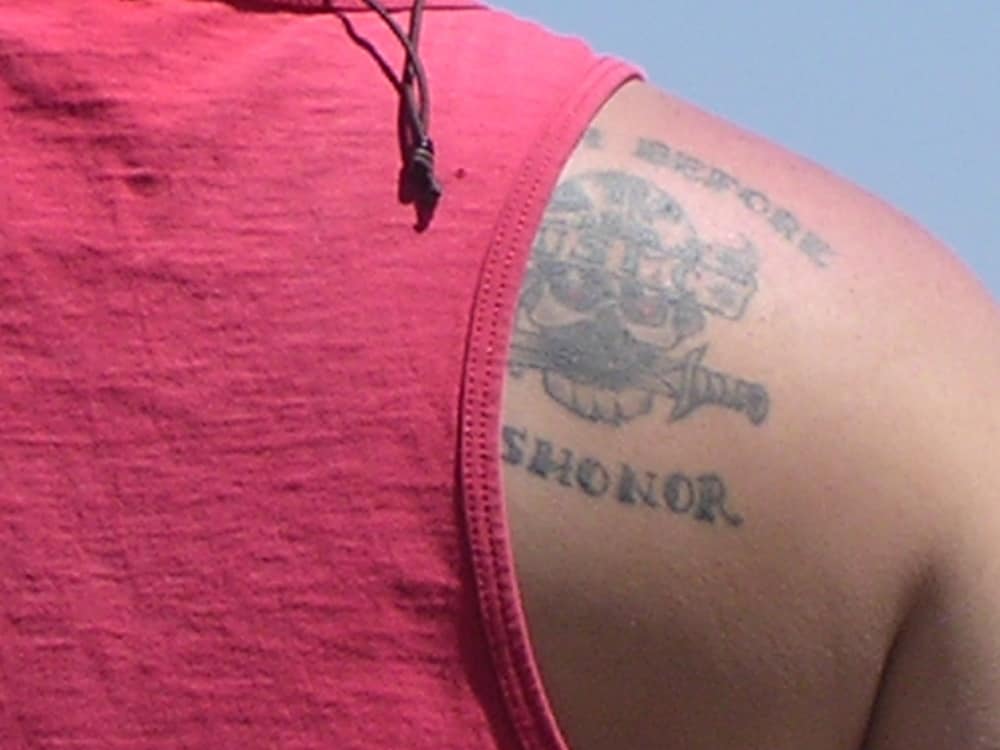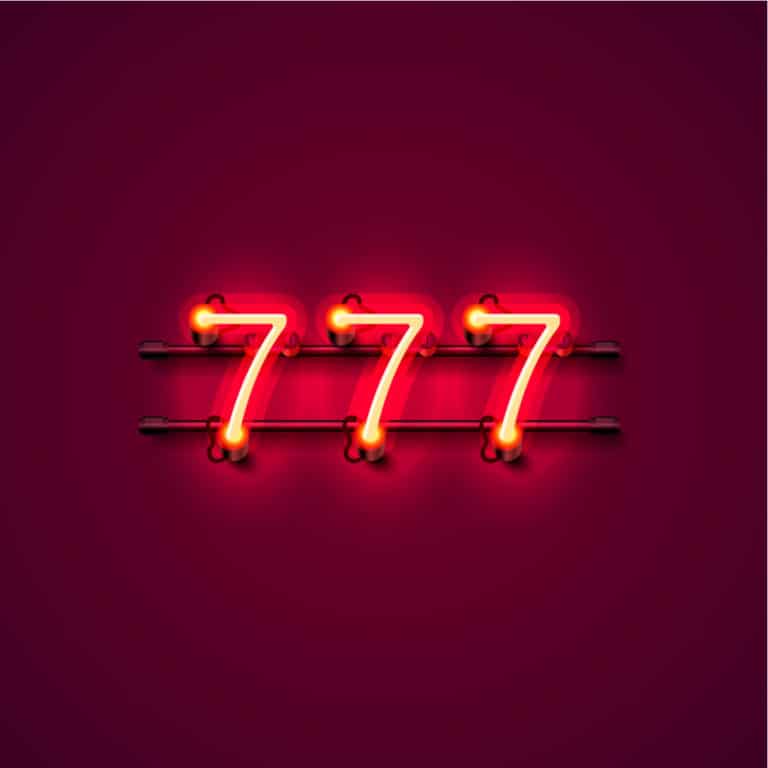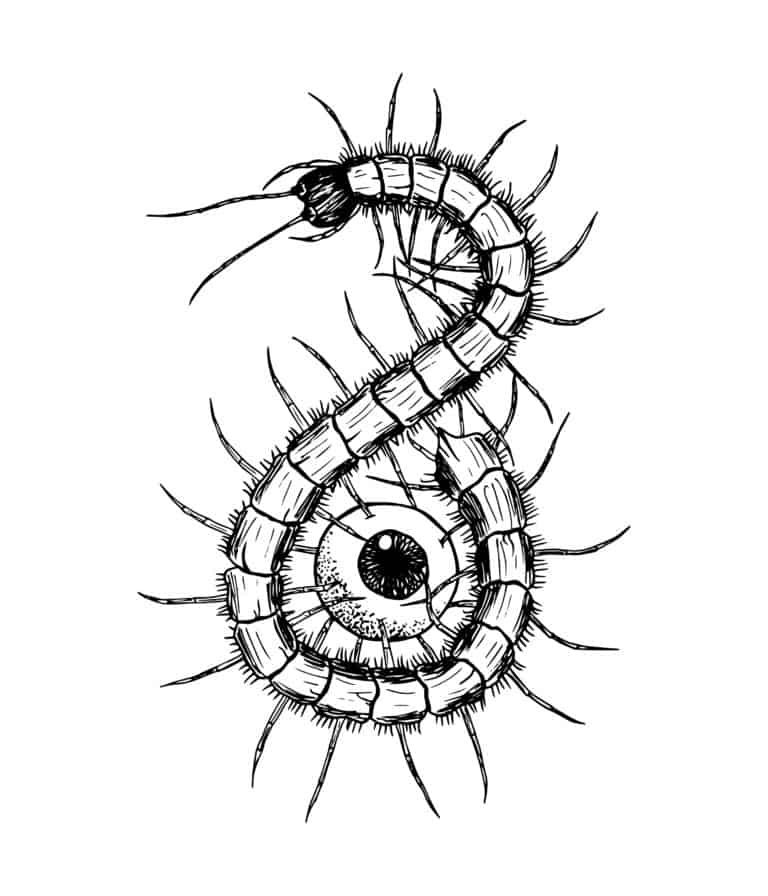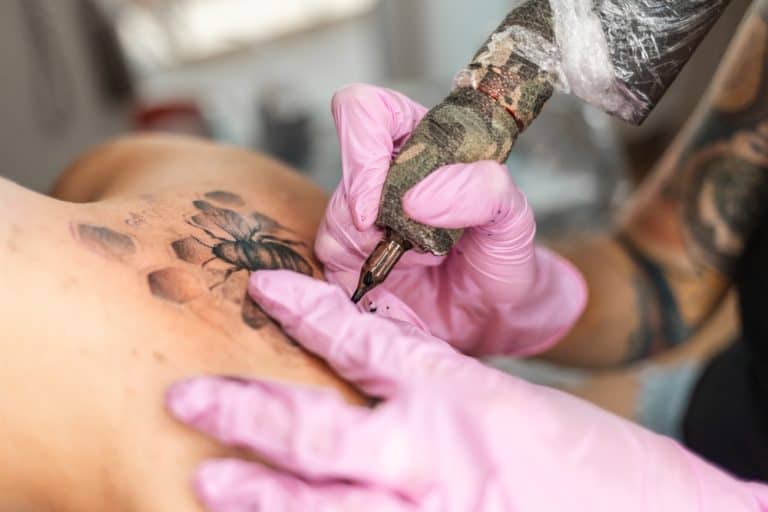Death Before Dishonor Tattoo Meaning
Image editorial credit: tatianatatianatatiana / Shutterstock.com
Even before Dr. Conrad Hawkings (Matt Crzuchry) flashed his ink on The Resident “Death Before Dishonor,” tattoos have been popular. There are vintage-looking flash art tattoos, often with a heart, sword, a banner with text that sometimes includes a skull. Then there are the more modern lettering tattoos, often as chest pieces. But what does the phrase mean?
The modern “Death Before Dishonor” tattoo is tied to United States patriotism with roots in the US military. However, the phrase dates further back, with ties to Napoleon, Julius Caesar, and most significantly, the samurai. The latter often depicted the phrase with the symbol of “The Three Tears.”
The phrase “Death Before Dishonor” (death before betrayal of country) didn’t pop up in English culture until around the 1800s. However, the phrase and its concept date further back, although it is hotly debated precisely when and by whom. Even today, who should be “allowed” to wear a “Death Before Dishonor” tattoo is a controversial topic in some circles.
Death Before Dishonor Marine & Military Tattoos
“Death Before Dishonor” is essentially about loyalty above the value of your own life. Those in the military, especially the United States Marines, embrace this patriotic value in their service. It isn’t just a tattoo; it is a state of mind. Thus, the phrase pops up in many areas of the military, including challenge coins.
Thus, many current service members of the US military and veterans have chosen this mantra as a tattoo. Also, those that have a loved one who died while serving the country sometimes obtain a “Death Before Dishonor” tattoo in their memory.
This generation of US military isn’t the first to embrace the ideals behind the “Death Before Dishonor” tattoo. While the styling has evolved, its roots date back to legendary Sailor Jerry (Norman Collins) and World War II.
Death Before Dishonor Tattoos In World War II
During World War II, “Death before Dishonor” was the most famous design of the five popular patriotic motifs obtained by service members, according to Bandielle Boiardi, Lyle Tuttle Tattoo Art Collection’s curator. Boiardi explained, “Tattoos that were meant to bolster their spirits…give them a sense of brave comradery.”
Some of the famous artists that inked these designs, including the “Death Before Dishonor,” are:
- Bert Grim
- Lou Normand
- Milton Zeis
- Red Farrell
- Sailor Jerry
- Sailor Bill Kingsworth
Death Before Dishonor Tattoos And American Patriotism
“Death Before Dishonor” is tied to American patriotism, similar to how the Ancient Romans used the phrase. Thus, not every person with a “Death Before Dishonor” tattoo necessarily served in the armed forces or lost a loved one who’d served. There are Americans who wear it out of loyalty to their country, a symbol that they’d rather die than betray the United States.
Death Before Dishonor Tattoos And Loyalty
In its most granular, “Death Before Dishonor” tattoos signify loyalty to those the wearer holds dear. For some, this is national pride and service, but to others, it can be to their community. These bands of people can take the shape of organizations such as mobs and gangs. Thus, the wearer would rather die than betray their community.
Death Before Dishonor And Japanese Samurai
The concept of “Death Before Dishonor” has deep roots in Japanese culture, especially in regard to the samurai. Their very name means “to serve.” Like many warriors, they had a code by which they lived. Thus, they were committed to the belief that death while in battle was better than dishonor.
Death Before Dishonor: Legend Of The Three Tears
The Japanese, and other cultures, have a symbol of three swirls, or “heads.” This symbol has many variations and has appeared on flags, carvings, tattoos, and is used in martial arts. It is known to some as Hidari Gomon but has other names, including being referred to as “The Three Tears,” the same as a popular legend. Thus, the symbol represents the legend and the code “Death Before Dishonor.”
Okinawan is the 5th largest Japanese island. However, Okinawan has not always been considered part of Japan and have their own language, history with their own rulers, and flags. For example, the flag of 1869 – 1875 was three “tomoe” that represented beauty, humanity, and tenderness. However, the flag’s tomoe is very reminiscent of The Three Tears.
The legend of The Three Tears is set during a time when Japan and Okinawan were not united. There are many versions of this legend, set either in the 16th or 17th century. However, all versions involve three swirling men and the belief in “Death Before Dishonor.” Here are two samples of the legend’s many forms.
Version 1: The Three Tears
The legend relates to the Okinawa royal family in the 16th century and the Japanese samurai, whose service, by this point, was politically linked. The samurai attacked the Okinawan king’s castle, where only one bodyguard remained alive.
Two samurai cornered the bodyguard at the top of the stairs. In desperation, the bodyguard grabbed the two samurai and hurdled them, and himself, into a boiling vat of oil. The remaining samurai were so moved by the body guard’s loyalty and courage they spared the lives of the king and his family.
Version 2: The Three Tears
The Ryukyu Kingdom lost a battle to the Lord of Kagoshima. While the king remained in power, Kagoshima imposed various rules and an annual rice tax. The people obeyed, paying their annual tax until the great drought left them with no rice to spare and people in dire need.
The Ryukyu King sent three messengers to ask for mercy, explaining that there was no rice due to the drought. Kagoshima was furious and ordered the samurai to kill the messengers. While the samurai initially failed, backup arrived, and they successfully subdued the messengers. A massive oil vat was filled with boiling water, and the three were tossed to their death.
As the messengers boiled, their anguished screams were not for their own lives but for the Ryukyuan people. They pleaded for mercy for those that already did not have enough to eat.
The Lord was incredibly moved that even while dying a brutal death, the messengers pleaded for their people and not for themselves. Thus, not only did he forgo the tax, he arranged for food aid to ease the Ryukyuan’s hardship.
Death Before Dishonor Tattoo Placements
A “Death Before Dishonor” tattoo can be placed wherever the user desires. The most popular placements at present are:
- Back
- Chest
- Ribs & Side
- Inner forearm
However, those in service must respect their military branch’s regulations regarding ink. The rules do change, but at present, only one branch allows a neck tattoo. None of the branches allow tattoos on the:
- Eyelids
- Face
- Hands (with a slight exception for “ring” designs in some branches)
- Head
- Lips
- Scalp
- Tongue
Western tattoos of “Death Before Dishonor” do not often depict The Three Tears symbol. However, some people in martial arts will have it inked. Generally, the Western versions of “Death Before Dishonor” involve text and perhaps motifs such as a skull, knife, sword, heart, snake, or a combination.
Conclusion
“Death Before Dishonor” tattoos have roots as old as the ancient Romans. While communities that use the phrase differ, from the Romans to the samurai, the meaning is the same: better to die loyal to your cause or loved one than to live in dishonor. Thus, in the United States, these tattoos are often a sign of patriotism and service to the armed forces.
Some of my favorite designs, tattoo books, and aftercare products, selected for you
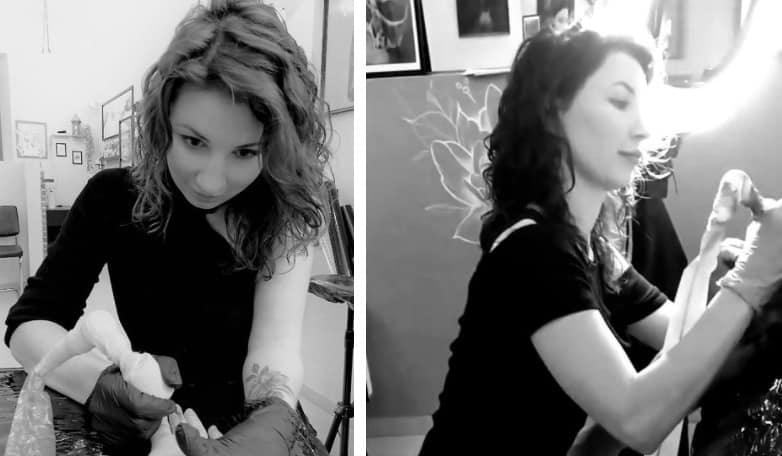
Thank you for reading my article, I hope that you have found it helpful. If you would have trouble finding ideas for your tattoo, wonder what is meaning of design that you have found or what to buy for aftercare, to make sure that your tattoo will be healing quickly and easily, here are some of my favorite products in one place, hope that this will also help.
Design and tattoo ideas
For some ideas you can have a look at those 3 books with hundreds of designs that I use with my clients, they are available on Amazon for Kindle or in classic, paper version (links below):
- Great Book of Tattoo Designs, Revised Edition: More than 500 Body Art Designs (Fox Chapel Publishing) Fantasy, Celtic, Floral, Wildlife, and Symbol Designs for the Skin by Lora Irish
- The Big Book of Small Tattoos – Vol.1: 400 small original tattoos for women and men by Roberto Gemori
- Tiny Tattoos: Over 1,000 Small Inspirational Artworks by Rebecca Vincent.
Tattoo meaning
If you would like to read more about the meaning of different tattoo styles and designs before you will decide what you would like to have, I can recommend a book that was really useful for me when I was starting my tattoo adventure – it’s “Conscious Ink: The Hidden Meaning of Tattoos” by Lisa Barretta (through the link you can find it on Amazon for around $10).
Tattoo aftercare
The skin at the tattoo site often dries out. To prevent it and speed up healing for my clients, I usually recommend one of those tattoo aftercare balms (you can find them on Amazon):
References
- https://nextluxury.com/mens-style-and-fashion/death-before-dishonor-tattoo-designs-for-men/
- https://www.historynet.com/death-before-dishonor-the-samurai-of-japan.htm
- https://www.amazon.com/Marine-Corps-Before-Dishonor-Challenge/dp/B07CMB6ZT3
- https://www.okinawan-shorinryu.com/okinawa/symbol.html
- https://sailorjerry.com/en/norman-collins/
- https://millenniummartialarts.perfectmind.com/Classes/Lounge/the-origin-of-the-okinawan-symbol-the-hidari-gonon
- https://airandspace.si.edu/stories/editorial/body-art-world-war-2-tattoo
- https://www.distractify.com/p/matt-czuchry-back-tattoo-real-the-resident
- https://www.operationmilitarykids.org/army-tattoo-policy/
- https://www.historynet.com/death-before-dishonor-the-samurai-of-japan.htm

